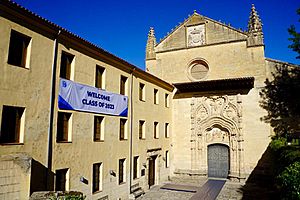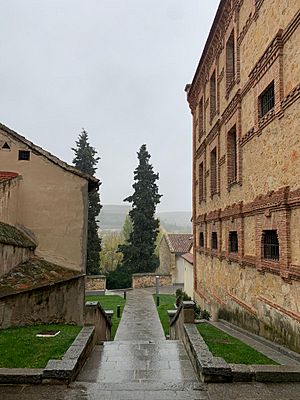Monastery of Santa Cruz la Real facts for kids
The Monastery of Santa Cruz la Real is a very old building in Segovia, Spain. It was built way back in the 1200s! Over time, it has been fixed up many times. Today, it's home to IE University. In 1985, a group called UNESCO said it was a special place, making it a World Heritage Site. This means it's important for everyone in the world to protect.
Contents
History of the Monastery
Early Years: 1200s to 1300s
The Monastery of Santa Cruz la Real was started by Saint Dominic de Guzman. He came to Segovia in late 1218. Around Christmas that year, he set up the first group of Dominican friars in Spain. This was just two years after the Dominicans, a religious order, began.
Saint Dominic became very popular in Segovia. People and even the kings liked him. He performed miracles, like bringing rain during a dry spell. Because of this, King Alfonso X of Castile gave the monastery 100 maravedís every year. Maravedís were a type of money back then.
Later kings, Ferdinand IV of Castile and Alfonso XI of Castile, also continued this yearly payment. This helped the monastery grow for many decades. For example, in 1326, the Segovia council gave the Dominicans wheat.
Royal Support: The 1400s
The monastery really started to grow when the Catholic Monarchs of Spain were in charge. These were Queen Isabella I and King Ferdinand II.
In 1478, Queen Isabella decided that the Inquisition would be controlled by the Spanish rulers, not just the Pope. Later, in 1492, the royals made a big decision. They approved the removal of the Jewish community from Spain. This event brought a lot of money to the friars at Santa Cruz.
The friars and the royal family stayed close. The Catholic Monarchs paid for many new buildings and repairs at the monastery.
They funded several important parts of the convent:
- The church, with its grand front entrance.
- The cloister, which is an open area surrounded by covered walkways. This showed the convent was growing. It now had areas for studying and storage.
- The Chapter Hall, a special room for meetings and prayer. It was named after Saint Vincent.
- The refectory, which was the dining hall.
- The royal chapel, known as the "Saint's Cave."
An architect named Juan Guas worked on these changes. He worked for the Spanish Crown. He changed the building's style from Romanesque to a new "Gothic-Isabelline style." This new style often featured symbols of the Catholic Monarchs.
The old building was used as a base for the new parts. Isabella and Ferdinand got money for these changes in a unique way. They took the money from a merchant named Garci Gonzalez Gualdrafas. He was punished in 1489.
The name Santa Cruz la Real means "Royal Holy Cross." This name shows that the kings and queens strongly protected the monastery.
Later Years: 1500s to 1900s
The Dominican monastery of Santa Cruz la Real became even more powerful during the Modern Era. Important people, like Cardinal Domingo Pimentel, gave money to create special chaplaincies there. This meant the convent became much richer and more active. Kings continued to give money to the convent every year. Many people also left money to the convent in their wills during the 1500s. Part of the convent was even used for teaching, with many professors working there.
Santa Cruz la Real also had a large collection of art. All of this art is now owned by the Segovia Province.
The 1700s and 1800s were difficult times for the convent. First, the government took away many church properties in 1836. This meant the Dominicans had to leave the convent. Second, Europe was in a period of war, including the Napoleonic Wars.
In 1836, the convent became a hospice, a place for people who are very ill. It also became a nursing home for older people. The Segovia Provincial Council owned it then. In 1843, they also opened a home for orphans there.
By the late 1800s, the convent was empty and not used. In the early 1900s, several fires damaged it. This led to it being left abandoned.
In 1963, a group of former residents organized events to remember those who had lived there.
In the late 1900s, the convent was fully fixed up. It was turned into a campus for Instituto de Empresas (IE University). This is a private university with campuses in Madrid and Segovia.
Monastery Architecture
Building History and Styles
Segovia is in northern Spain and was named a World Heritage Site by UNESCO in 1985. Segovia is famous for its cathedrals, its Alcazar castle, and its old aqueduct. Its historic buildings show the influence of Romanesque art.
The convent was the first one started by the Dominicans in Spain in 1218. The city of Segovia gave some houses to Santo Domingo De Guzman. He used these to create the convent. The building was rebuilt many times. Because of this, its architecture shows different styles. You can see parts from the Romanesque times. There are also later additions in the Hispano-Flemish style and Renaissance-style cloisters. All these styles combine to make it look as it does today.
Key Structures
The old convent was rebuilt in the 1200s. Then, the church and its grand entrance were built. This work was led by brother Tomas De Torquemada.
The Cave of Saint Dominic is on the north side of the church. Today, you reach it through an antechapel. This antechapel was built when the Catholic Monarchs were in power. It used to be connected to the monastery by a small passage.
The convent has a church. Today, IE University uses it as its main conference room. The refectory (dining hall) and the chapter room (meeting hall) have also been changed into conference halls.
See also
 In Spanish: Convento de Santa Cruz la Real para niños
In Spanish: Convento de Santa Cruz la Real para niños




